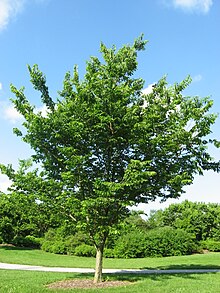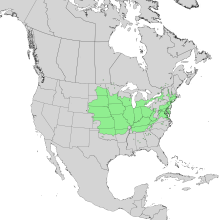| Common hackberry | |
|---|---|

| |
| Scientific classification | |
| Kingdom: | Plantae |
| Clade: | Tracheophytes |
| Clade: | Angiosperms |
| Clade: | Eudicots |
| Clade: | Rosids |
| Order: | Rosales |
| Family: | Cannabaceae |
| Genus: | Celtis |
| Species: | C. occidentalis
|
| Binomial name | |
| Celtis occidentalis | |

| |
| Native range | |
Celtis occidentalis, commonly known as the common hackberry, is a large deciduous tree native to North America. It is also known as the nettletree, beaverwood, northern hackberry, and American hackberry.[4] It is a moderately long-lived[4] hardwood[4] with a light-colored wood, yellowish gray to light brown with yellow streaks.[5]
The common hackberry is easily distinguished from elms and some other hackberries by its cork-like bark with wart-like protuberances. The leaves are distinctly asymmetrical and coarse-textured. It produces small fruits that turn orange-red to dark purple in the autumn, often staying on the trees for several months. The common hackberry is easily confused with the sugarberry (Celtis laevigata) and is most easily distinguished by range and habitat. The common hackberry also has wider leaves that are coarser above than the sugarberry.
- ^ Stritch, L. (2018). "Celtis occidentalis". IUCN Red List of Threatened Species. 2018: e.T61987996A61987998. doi:10.2305/IUCN.UK.2018-1.RLTS.T61987996A61987998.en. Retrieved 19 November 2021.
- ^ Cite error: The named reference
NatureServewas invoked but never defined (see the help page). - ^ Celtis occidentalis was first described and published in Species Plantarum 2: 1044. 1753 "Plant Name Details for Genus epithet". IPNI. Retrieved June 10, 2011.
- ^ a b c Krajicek, John E.; Williams, Robert D. (1990). "Celtis occidentalis". In Burns, Russell M.; Honkala, Barbara H. (eds.). Hardwoods. Silvics of North America. Vol. 2. Washington, D.C.: United States Forest Service (USFS), United States Department of Agriculture (USDA) – via Southern Research Station.
- ^ "Hackberry" Archived June 10, 2009, at the Wayback Machine Clary Wood Products Gallery

